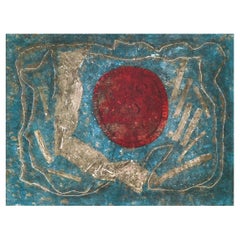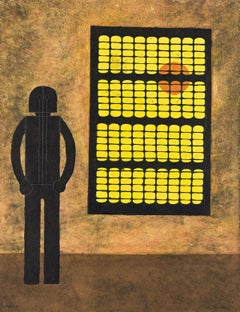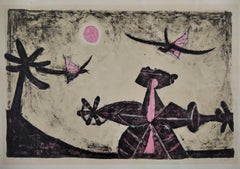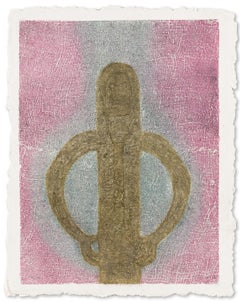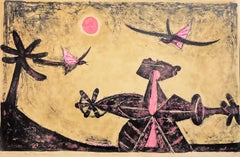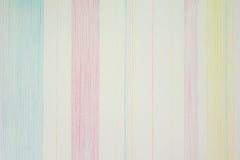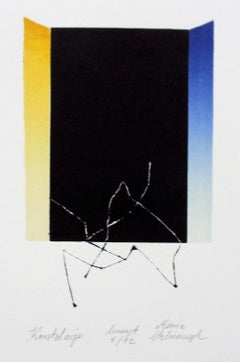Rufino Tamayo More Prints
Mexican, 1899-1991
Rufino Tamayo was born in Oaxaca, Mexico, in 1899 to parents Manuel Arellanes and Florentina Tamayo. Tamayo was active in the mid-20th century in Mexico and New York, painting figurative abstraction with surrealist influences. Although Tamayo studied drawing at the Academy of Art at San Carlos as a young adult, he became dissatisfied and eventually decided to study on his own.
to
2
2
1
1
Overall Width
to
Overall Height
to
2
2
1
58
678
450
226
178
6
1
2
1
4
2
1
1
3
3
2
2
5
1
Artist: Rufino Tamayo
Mascara Roja
By Rufino Tamayo
Located in San Francisco, CA
This artwork titled "Mascara Roja" 1969 is an original colors lithograph on B.F.K. Rives paper by renown Mexican artist Rufino Tamayo, 1899-1991. It is hand signed and inscribed H.C. (Hors Commerce) in pencil by the artist. The image size is 21 x 27.25 inches, framed size is 37.25 x 42 inches. Published by Touchtone Publisher, New York, printed by Ateliers Desjobert, Paris. Referenced and pictured in the artist's catalogue raisonne by Pereda, plate #124. Custom framed in a wooden gold leaf frame, with gold and red spacer and fabric matting. It is in excellent condition.
About the artist:
A native of Oaxaca in Southern Mexico, Rufino Tamayo's father was a shoemaker, and his mother a seamstress. Some accounts state that he was descended from Zapotec Indians, but he was actually 'mestizo' - of mixed indigenous/European ancestry. (Santa Barbara Museum of Art). He began painting at age 11. Orphaned at the age of 12, Tamayo moved to Mexico City, where he was raised by his maternal aunt who owned a wholesale fruit business.
In 1917, he entered the San Carlos Academy of Fine Arts, but left soon after to pursue independent study. Four years later, Tamayo was appointed the head designer of the department of ethnographic drawings at the National Museum of Archaeology in Mexico City. There he was surrounded by pre-Colombian objects, an aesthetic inspiration that would play a pivotal role in his life. In his own work, Tamayo integrated the forms and tones of pre-Columbian ceramics into his early still lives and portraits of Mexican men and women.
In the early 1920s he also taught art classes in Mexico City's public schools. Despite his involvement in Mexican history, he did not subscribe to the idea of art as nationalistic propaganda. Modern Mexican art at that time was dominated by 'The Three Great Ones' : Diego Rivera, Jose Clemente Orozco, and David Alfaro Siqueros, but Tamayo began to be noted as someone 'new' and different' for his blending of the aesthetics of post Revolutionary Mexico with the vanguard artists of Europe and the United States.
After the Mexican Revolution, he focused on creating his own identity in his work, expressing what he thought was the traditional Mexico, and refusing to follow the political trends of his contemporary artists. This caused some to see him as a 'traitor' to the political cause, and he felt it difficult to freely express himself in his art. As a result, he decided to leave Mexico in 1926 and move to New York, along with his friend, the composer Carlos Chavez. The first exhibition of Tamayo's work in the United States was held at the Weyhe Gallery, New York, in that same year. The show was successful, and Tamayo was praised for his 'authentic' status as a Mexican of 'indigenous heritage', and for his internationally appealing Modernist aesthetic. (Santa Barbara Museum of Art).
Throughout the late thirties and early forties New York's Valentine Gallery gave him shows. For nine years, beginning in 1938, he taught at the Dalton School in New York.
In 1929, some health problems led him to return to Mexico for treatment. While there he took a series of teaching jobs. During this period he became romantically involved with the artist Maria Izquierdo...
Category
Mid-20th Century Modern Rufino Tamayo More Prints
Materials
Lithograph
Rufino Tamayo Original Mixografica, 1976, Sol
By Rufino Tamayo
Located in Phoenix, AZ
Mixografia on Paper “Sol (The Sun)” by well-known Mexico artist Rufino Tamayo (1891-1991).
Signed “R. Tamayo” lower right. Numbered lower left 96/140. Created 1976.
In excellent cond...
Category
1970s Rufino Tamayo More Prints
Materials
Paper
Hombre en la Ventana
By Rufino Tamayo
Located in New York, NY
Pencil signed and numbered 74/100 in black crayon in lower margin. Printed by Taller de Gráfica Mexicana, Mexico City.
A very good impression with vibrant colors. The current prin...
Category
1980s Modern Rufino Tamayo More Prints
Materials
Handmade Paper, Color
Untitled
By Rufino Tamayo
Located in Barcelona, BARCELONA
The painting is being offered with a work and authenticity certificate
Category
1990s Abstract Expressionist Rufino Tamayo More Prints
Materials
Lithograph
Personaje con Red
By Rufino Tamayo
Located in New York, NY
A very good impression of this large, color Mixografía print on handmade paper. Signed and numbered 20/100 in pencil. Printed and published by Taller de Gráfica Mexicana, Mexico City...
Category
1980s Surrealist Rufino Tamayo More Prints
Materials
Handmade Paper, Color
Observador de Pajaros
By Rufino Tamayo
Located in Missouri, MO
"Observador de Pajaros" 1950
By. Rufino Tamayo (Mexican, 1899-1991)
Edition 83/200 Lower Right
Signed Lower Left
Unframed: 15.5" x 22.5"
Framed: 21.75" x 28.25"
Rufino Tamayo (August 26, 1899- June 24, 1991)
A native of Oaxaca in Southern Mexico, Rufino Tamayo's father was a shoemaker, and his mother a seamstress. Some accounts state that he was descended from Zapotec Indians, but he was actually 'mestizo' - of mixed indigenous/European ancestry. (Santa Barbara Museum of Art). He began painting at age 11. Orphaned at the age of 12, Tamayo moved to Mexico City, where he was raised by his maternal aunt who owned a wholesale fruit business.
In 1917, he entered the San Carlos Academy of Fine Arts, but left soon after to pursue independent study. Four years later, Tamayo was appointed the head designer of the department of ethnographic drawings at the National Museum of Archaeology in Mexico City. There he was surrounded by pre-Colombian objects, an aesthetic inspiration that would play a pivotal role in his life. In his own work, Tamayo integrated the forms and tones of pre-Columbian ceramics into his early still lives and portraits of Mexican men and women.
In the early 1920s he also taught art classes in Mexico City's public schools. Despite his involvement in Mexican history, he did not subscribe to the idea of art as nationalistic propaganda. Modern Mexican art at that time was dominated by 'The Three Great Ones' : Diego Rivera, Jose Clemente Orozco, and David Alfaro Siqueros, but Tamayo began to be noted as someone 'new' and different' for his blending of the aesthetics of post Revolutionary Mexico with the vanguard artists of Europe and the United States.
After the Mexican Revolution, he focused on creating his own identity in his work, expressing what he thought was the traditional Mexico, and refusing to follow the political trends of his contemporary artists. This caused some to see him as a 'traitor' to the political cause, and he felt it difficult to freely express himself in his art. As a result, he decided to leave Mexico in 1926 and move to New York, along with his friend, the composer Carlos Chavez. The first exhibition of Tamayo's work in the United States was held at the Weyhe Gallery, New York, in that same year. The show was successful, and Tamayo was praised for his 'authentic' status as a Mexican of 'indigenous heritage', and for his internationally appealing Modernist aesthetic. (Santa Barbara Museum of Art).
Throughout the late thirties and early forties New York's Valentine Gallery gave him shows. For nine years, beginning in 1938, he taught at the Dalton School in New York.
In 1929, some health problems led him to return to Mexico for treatment. While there he took a series of teaching jobs. During this period he became romantically involved with the artist Maria...
Category
20th Century Abstract Rufino Tamayo More Prints
Materials
Lithograph
Price Upon Request
Related Items
Ferris Wheel: abstract modern minimalist color field drawing with rainbow colors
By Gene Davis
Located in New York, NY
This geometric, minimalist print glows in rainbow shades. Vibrant raspberry pink, magenta, yellow, lime green, and sky-blue lines take on the organic quality of handmade paper, resul...
Category
1970s Abstract Rufino Tamayo More Prints
Materials
Lithograph
$1,350
H 30.25 in W 39.75 in
Constellation - XXI Century, Contemporary Linocut & Woodcut Print, Abstract
By Maria Stelmaszczyk
Located in Warsaw, PL
MARIA STELMASZCZYK (born in 1983) Studies at the Faculty of Graphic Arts and Painting
Laboratory of Woodcut Techniques and Artistic Book at the Academy of Fine Arts Władysław Strzemi...
Category
Early 2000s Contemporary Rufino Tamayo More Prints
Materials
Paper, Linocut, Woodcut
$160 Sale Price
20% Off
H 5.52 in W 3.55 in
Original "American Labor ... Producing for Attack" vintage 1943 poster
Located in Spokane, WA
Original AMERICAN LABOR - PRODUCING FOR ATTACK vintage 1943 poster. Size: 19.5" x 22.25. Professional archival linen backed; ready to frame. War Production Board, Washington D.C.
Original. Lithograph. printed by the US Government...
Category
1940s American Modern Rufino Tamayo More Prints
Materials
Offset
$398 Sale Price
20% Off
H 27.25 in W 19.5 in D 0.05 in
Addison Gallery 1982 SIGNED Frank Stella Vintage Poster, metallic rainbow
By Frank Stella
Located in New York, NY
This shimmering, metallic vintage poster with rainbow text and layers of texture must be seen in person to appreciate Frank Stella's masterful design. Original exhibition poster for Frank Stella’s Metal Reliefs exhibition at the Addison Gallery...
Category
Late 20th Century Abstract Rufino Tamayo More Prints
Materials
Lithograph
Original Pan American World Airways by Clipper to Portugal and Spain poster
By Jean Carlu
Located in Spokane, WA
Original vintage poster: Portugal and Spain by Pan American World Airways Clipper, Artist: Jean Carlu. Pan American original vintage poster large travel size format 27.5" x 41.1" Earliest version (the 1950s) of the poster for travel by Constellation aircraft.
Original linen-backed, Pan American World Airways by Clipper vintage poster for travel to Portugal and Spain. Wear and stress marks in the top and bottom dark area but are not tears.. Small touch-up on the left white border.
In the middle of this image, it features a matador with a cape hanging off his shoulder. Surrounding the image in vignettes of cut-out windows showing typical landscape scenes and castles. A great smaller format original for "The World's Most Experienced Airline". One of the windmills shown in this image has cloth sails. Trimming the sails allowed the windmill to turn at near the optimal speed in a large range of wind velocities. Pan American World Airways by Clipper.
Pan American a.k.a. Pan Am Airlines posters are very collectible and rare year to year. This a great design opportunity for a home with a European flair. The Pan Am Clipper...
Category
1950s American Modern Rufino Tamayo More Prints
Materials
Lithograph
$1,598
H 42 in W 27.5 in D 0.05 in
Octavio Paz Suite: Nocturne VI
By Robert Motherwell
Located in London, GB
Lithograph and chine appliqué
64.5 x 54 cms (25 3/8 x 21 1/4 ins)
Edition 50
Paper: Arches paper; Japanese Gampi handmade paper
Other Collaborators: Image transferred from Mylar to...
Category
1980s Abstract Expressionist Rufino Tamayo More Prints
Materials
Handmade Paper, Color, Lithograph
Surrealist Portrait of Dali Surrounded by Butterflies, Memories of Surrealism
By Salvador Dalí
Located in Washington, DC
Artist: Salvador Dali
Title: Surrealist Portrait of Dali Surrounded by Butterflies
Portfolio: Memories of Surrealism
Medium: Etching and photolithograph
Date: 1971
Edition: AP XIV/XX...
Category
1970s Surrealist Rufino Tamayo More Prints
Materials
Etching, Lithograph
$4,195
H 35.5 in W 29.5 in
Max Ernst Dada Surrealist Hand Signed Lithograph Poster for a Jewish Museum
By Max Ernst
Located in Surfside, FL
Max Ernst (German, American, 1891-1976)
Color lithograph
Titled, "Poster For The Jewish Museum"
1966
Hand signed lower right
Hand numbered HC I/XVII
Dimensions: 34.75 x 28.5 sight 25 X 19.25
Max Ernst (German 1891 – 1976) was a German-born painter, sculptor, printmaker, graphic artist, and poet. A prolific artist, Ernst was a primary pioneer of the Dada movement and surrealism in Europe. He had no formal artistic training, but his experimental attitude toward the making of art resulted in his invention of frottage—a technique that uses pencil rubbings of textured objects and relief surfaces to create images—and grattage, an analogous technique in which paint is scraped across canvas to reveal the imprints of the objects placed beneath.
Max Ernst showed for the first time in 1912 at the Galerie Feldman in Cologne. At the Sonderbund exhibition of that year in Cologne he saw the work of Paul Cezanne, Edvard Munch, Pablo Picasso, Paul Gauguin and Vincent van Gogh. In 1913 he met Guillaume Apollinaire and Robert Delaunay and traveled to Paris. Ernst participated that same year in the Erste deutsche Herbstsalon.
In 1914 he met Jean Arp in Cologne who was to become a lifelong friend. In 1921 Ernst exhibited at the Galerie au Sans Pareil in Paris. He was involved in Surrealist activities in the early 1920s with Paul Eluard and André Breton. His work was exhibited that year together with that of the Das Junge Rheinland group, at Galerie Feldman in Cologne, and then in several group exhibitions in 1913. In his paintings of this period, Ernst adopted an ironic style that juxtaposed grotesque elements alongside Cubist and Expressionist motifs.
Ernst fought in world war I. Several German Expressionist painters died in action during the war, among them August Macke and Franz Marc. In 1918, Ernst was demobilised and returned to Cologne. He soon married art history student Luise Straus, of Jewish ancestry, whom he had met in 1914. In 1919, he visited Paul Klee in Munich and studied paintings by Giorgio de Chirico. In the same year, inspired by de Chirico and mail-order catalogues, teaching-aide manuals and similar sources, he produced his first collage works (notably Fiat modes, a portfolio of lithographs), a technique which later dominated his artistic pursuits. Also in 1919, Ernst, social activist Johannes Theodor Baargeld and several colleagues founded the Cologne Dada group. In 1919–20, Ernst and Baargeld published various short-lived magazines such as Der Strom, die Schammade and organised Dada exhibitions.
Ernst and Luise's son Ulrich Jimmy Ernst was born on 24 June 1920; he later would also become a painter. In 1921, he met Paul Éluard, who became a lifelong friend. Éluard bought two of Ernst's paintings (Celebes and Oedipus Rex) and selected six collages to illustrate his poetry collection Répétitions. A year later the two collaborated on Les malheurs des immortels and then with André Breton, whom Ernst met in 1921, on the magazine Littérature.
Ernst developed a fascination with birds which was prevalent in his work. His alter ego in paintings, which he called Loplop, was a bird. He suggested that this alter-ego was an extension of himself stemming from an early confusion of birds and humans. In 1927, he married Marie-Berthe Aurenche and it is thought his relationship with her may have inspired the erotic subject matter of The Kiss and other works of that year.
He collaborated with Joan Miro on designs for Sergei Diaghilev Ballet that same year. The following year the artist collaborated with Salvador Dali and the Surrealist Luis Bunuel on the film L'Age d'or. His first American show was held at the Julien Levy Gallery, New York, in 1932. In 1936 Ernst was represented in Fantastic Art, Dada, Surrealism at the Museum of Modern Art in New York. Ernst began to sculpt in 1934 and spent time with Alberto Giacometti. In 1938, the American heiress and artistic patron Peggy Guggenheim acquired a number of Max Ernst's works, which she displayed in her new gallery in London.
Ernst and Guggenheim were married from 1942 to 1946.
In September 1939, the outbreak of World War II caused Ernst, being German, to be interned as an "undesirable foreigner" in Camp des Milles, near Aix-en-Provence, along with fellow surrealist, Hans Bellmer, who had recently emigrated to Paris. He had been living with his lover and fellow surrealist painter, Leonora Carrington who, not knowing whether he would return, saw no option but to sell their house to repay their debts and leave for Spain. Thanks to the intercession of Paul Éluard and other friends, including the journalist Varian Fry, he was released a few weeks later. Soon after the German occupation of France, he was arrested again, this time by the Gestapo, but managed to escape to America with the help of Fry and Peggy Guggenheim, a member of a wealthy American art collecting family. Ernst and Peggy Guggenheim arrived in the United States in 1941 and were married at the end of the year. Along with other artists and friends (Marcel Duchamp and Marc Chagall) who had fled from the war and lived in New York City, Ernst helped inspire the development of abstract expressionism. His marriage to Guggenheim did not last. In October 1946 he married American surrealist painter Dorothea Tanning in a double ceremony with Man Ray and Juliet P. Browner in Beverly Hills, California. The couple made their home in Sedona, Arizona from 1946 to 1953. He and Tanning hosted intellectuals and European artists such as Henri Cartier-Bresson and Yves Tanguy. Sedona proved an inspiration for the artists and for Ernst, who compiled his book Beyond Painting and completed his sculptural masterpiece Capricorn while living in Sedona. As a result of the book and its publicity, Ernst began to achieve financial success. From the 1950s he lived mainly in France. In 1954 he was awarded the Grand Prize for painting at the Venice Biennale.
In 2005, "Max Ernst: A Retrospective" opened at the Metropolitan Museum of Art. Contemporary artist tapestries have had their true believers. He produced a tapestry for Gloria Ross...
Category
1960s Surrealist Rufino Tamayo More Prints
Materials
Lithograph
Personnage et Oiseau by Joan Miro, 1984
By Joan Miró
Located in New York, NY
This colorful lithographic was printed at the Atelier Mourlot in 1984 after Miro's 'Personnage et Oiseua', 1969, depicting the abstract form of a head with birds. This print has been blind embossed with the Galerie Mourlot...
Category
1960s Abstract Rufino Tamayo More Prints
Materials
Lithograph
Original Algeciras Feria 1948 vintage Spanish travel lithograph poster
Located in Spokane, WA
Original vintage poster Algeciras Feria 1948 vintage Spanish travel poster. Archival linen backed in very fine condition, ready to frame. N...
Category
1940s American Modern Rufino Tamayo More Prints
Materials
Lithograph
$1,080 Sale Price
20% Off
H 39.5 in W 27.75 in D 0.05 in
The Darker Palette print, Hand signed twice and inscribed by Helen Frankenthaler
By Helen Frankenthaler
Located in New York, NY
Helen Frankenthaler (after)
Frankenthaler: The Darker Palette (autographed and inscribed), 1998
Offset Lithograph print
42 × 35 in
hand signed "Frankenthaler" lower left; inscribed a...
Category
1990s Abstract Expressionist Rufino Tamayo More Prints
Materials
Offset, Lithograph
Lt Ed. Lithograph from the Deluxe (Hand Signed) 1984 Olympic Committee portfolio
By Sam Francis
Located in New York, NY
Sam Francis
Untitled Abstract Expressionist print for the 1984 Olympics, 1982
Offset Lithograph on Parsons Diploma Parchment paper, hand signed with COA from publisher for Olympic Co...
Category
1980s Abstract Expressionist Rufino Tamayo More Prints
Materials
Pencil, Lithograph, Offset
$2,800
H 36 in W 6 in D 6 in
Previously Available Items
"Cabeza con Sombrero" Mixografia
By Rufino Tamayo
Located in San Francisco, CA
This artwork titled "Cabeza con Sombrero" 1977, is a original Color Mixografia on Arches paper by renown Mexican artist Rufino Tamayo, 1899-1991. It is hand signed and numbered 46/100 in pencil by the artist. The sartwork size is 17 x 11.85 inches, framed size is 29.25 x 23.5 inches. Printed by Taller de Grafica Mexicana, Mexico. Referenced and pictured in the artist's catalogue raisonne by Pereda, plate #227 page 184. Custom framed in a wooden gold frame, with double spacer and double fabric matting. It is in excellent condition.
Will provide the buyer with a certificate of authenticity from our gallery and photocopy of the pages related to this artwork from the artist's catalogue raisonne.
About the artist:
A native of Oaxaca in Southern Mexico, Rufino Tamayo's father was a shoemaker, and his mother a seamstress. Some accounts state that he was descended from Zapotec Indians, but he was actually 'mestizo' - of mixed indigenous/European ancestry. (Santa Barbara Museum of Art). He began painting at age 11. Orphaned at the age of 12, Tamayo moved to Mexico City, where he was raised by his maternal aunt who owned a wholesale fruit business.
In 1917, he entered the San Carlos Academy of Fine Arts, but left soon after to pursue independent study. Four years later, Tamayo was appointed the head designer of the department of ethnographic drawings at the National Museum of Archaeology in Mexico City. There he was surrounded by pre-Colombian objects, an aesthetic inspiration that would play a pivotal role in his life. In his own work, Tamayo integrated the forms and tones of pre-Columbian ceramics into his early still lives and portraits of Mexican men and women.
In the early 1920s he also taught art classes in Mexico City's public schools. Despite his involvement in Mexican history...
Category
Mid-20th Century Modern Rufino Tamayo More Prints
Materials
Other Medium
Rufino Tamayo more prints for sale on 1stDibs.
Find a wide variety of authentic Rufino Tamayo more prints available for sale on 1stDibs. You can also browse by medium to find art by Rufino Tamayo in lithograph, handmade paper, paper and more. Much of the original work by this artist or collective was created during the 20th century and is mostly associated with the modern style. Not every interior allows for large Rufino Tamayo more prints, so small editions measuring 21 inches across are available. Customers who are interested in this artist might also find the work of Jasper Johns, Jean Dubuffet, and Adolph Gottlieb. Rufino Tamayo more prints prices can differ depending upon medium, time period and other attributes. On 1stDibs, the price for these items starts at $5,011 and tops out at $12,500, while the average work can sell for $9,500.
Artists Similar to Rufino Tamayo
Questions About Rufino Tamayo More Prints
- 1stDibs ExpertApril 5, 2022Mexican painter Rufino Tamayo had over 1300 oil paintings. He also worked in a variety of other mediums, but most of his work was done with vibrantly colored oil paint and this is the highlight of his legacy. Browse an array of authentic Rufino Tamayo pieces and prints on 1stDibs.
- 1stDibs ExpertFebruary 13, 2024The type of art that Rufino Tamayo painted was primarily figurative abstraction. Although Tamayo studied drawing at the Academy of Art at San Carlos as a young adult, the Mexican artist became dissatisfied and eventually decided to study on his own. Some of his most famous works include Watermelons, Three People, Moon and Sun, Woman in Grey, The Troubadour and Moon Dog. Find a variety of Rufino Tamayo art on 1stDibs.
